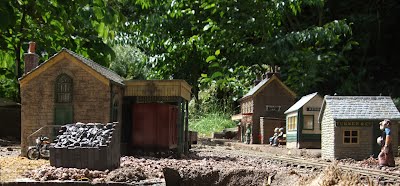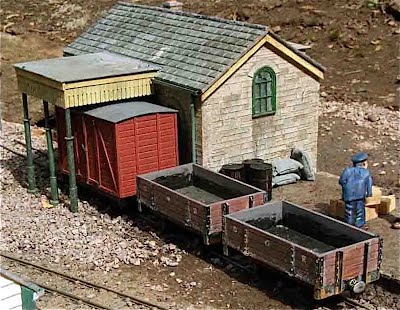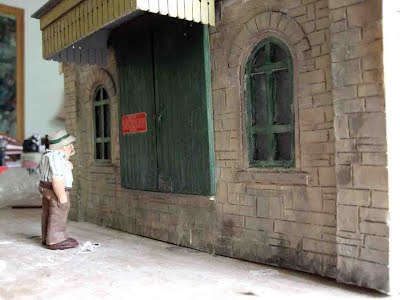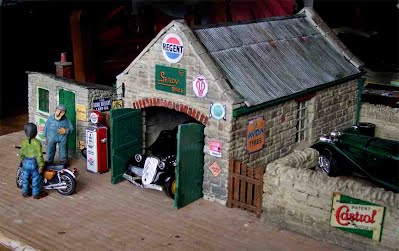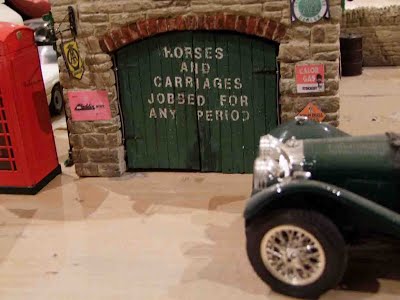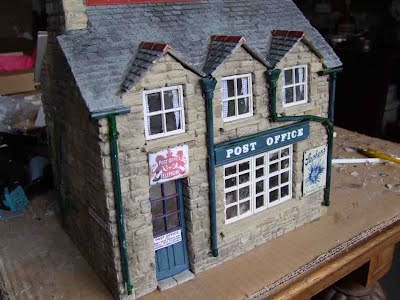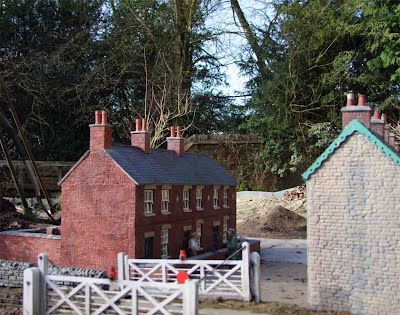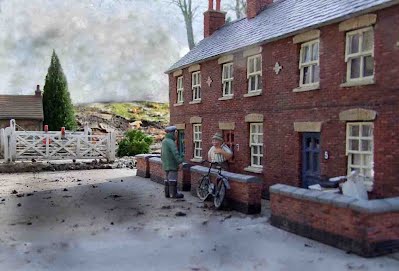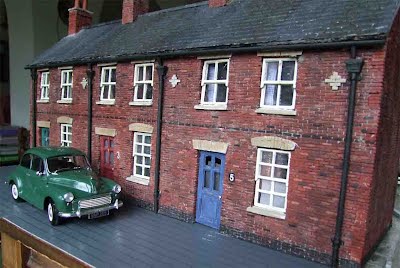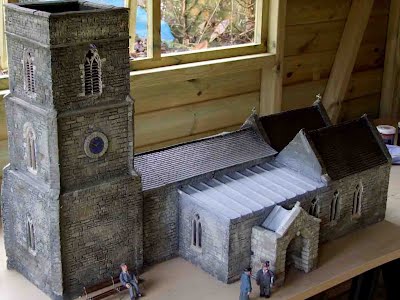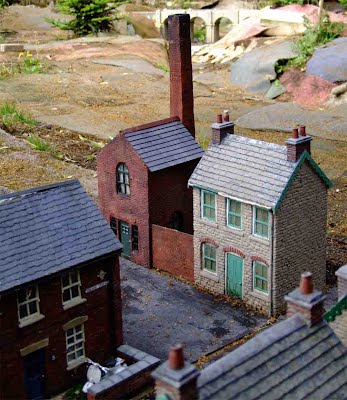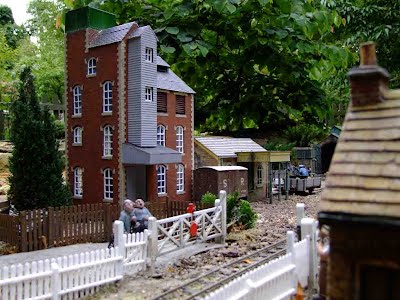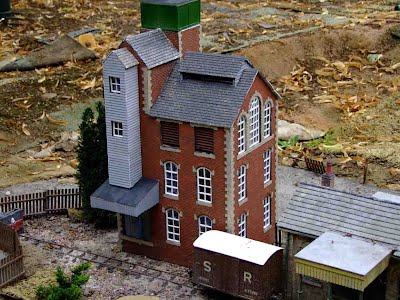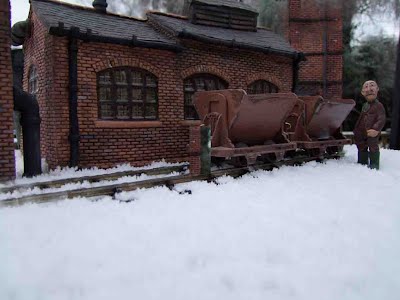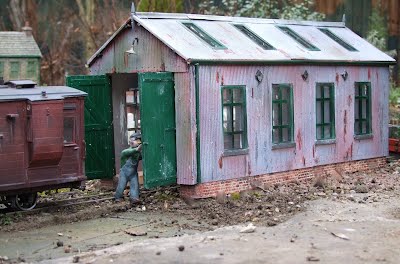I came to railways as a hobby all too late in life. I have always been a military modeller and have a massive 15mm Napoleonic Imperial Guard. I also want another crime to be taken into consideration. I dabbled in Dolls house miniatures for a while. I did once have a small OO gauge set-up but it tended to be about creating scale dioramas, not the running of trains at all. My brother in law. Dick, has a loft full of it and I could do the same now but it does not grab me as it does him and his grandson.
The linking factor, I realise, is miniaturisation. For me, it is about what gladdens the eye and I am so delighted to discover that a scale of about 1/20th has it all. Small enough to have a lot of stuff in a modest space but big enough to get your hands on and create detail to your heart's content. If you want all the rivets, you can have them. If you want to just suggest a line of rivets with the intelligent touch of a paint brush you can get away with it. If you want coach interiors, whoopee! If like me you wouldn't even peer inside, you can leave it out. Perfect!
On this page I will show some of the buildings I have created for my layout and perhaps offer some tips for those who want to follow my lead. Not to suggest that I am some sort of pioneer; it has all been done before. The things I will mention are more along the lines of 'I did this and it worked. I did that and it was crap'.
What buildings?
To begin with, of course, I needed stations and loco sheds, signal boxes and coaling stages. These are readily available in kit form, made of resin, and they look good and survive well outside if properly finished. For me though, the problem is often the lack of choice and detailing and the relative cost of buying something that somebody else has designed and wants to make conmmercially relevant. Part of my joy in this is to be creative without unnecesary restrictions. On the other hand, I have no desire to re-invent every wheel. It's a compromise. Sometimes this can be achieved by the so-called 'kit-bashing'; taking an available kit and tweaking it to do precisely what I want.
So, I tried a few of the usual resin kits and discovered that they were OK if expensive and kind of so-so and that they needed a deal of work often to make them acceptable. Some for example came with no guttering or downpipes. Now, the casual eye might not, no, probably would not notice. But I do. My eye is not gladdened!
Jigstones
The use of rubber moulds to cast building blocks is pretty old hat and I remember such things when I was a boy. The beauty of Jigstones is that they are about our scale. Better than that, they come in several patterns; brick, dressed stone, slate and random stone, allowing you to choose the appearance you want. In my village we have all sorts of rum buildings and only stacked slate is missing, We even have buildings that are a mixture of stone and red brick. One of them is an 18th century listed parsonage.
I like to think of the building as a real thing with its own story. Grady Bros Garage began life as a thatched barn which for a while was used as a livery stable. The expensive thatch was replaced by corrugated iron just before WW2 when there was no question about planners forcing you to replace thatch with thatch. How Terry got his AA approval is a mystery in the village. All he wants to do is get on with tinkering with the Vicar's Citroen Light 15 but Wayne has a problem with his bike.
Terry never bothered to repaint the doors.
The post office began as a simply box but then the dormers sort of grew. Do you see what I mean about the guttering and pipes? The stone walls are cast using fast setting concrete, neat. Some people add sand to the mix. That didn't work for me so I gave it up very soon. In addition to the main building blocks, the roof, windows, doors, sills, the water traps, junctions and things to fix the pipes to the wall, (whatever they are called) are also all cast from jigstones moulds but using Isopon P38. Only the pipes are bought in plastruct tube. I even cast the chimney pots. It's a piece of cake.
This is the latest Jigstones project; a red brick terrace. You can see the individual building blocks which will become the back yards and outside khazis. In fact, I built them and painted them this very afternoon instead of doing what I ought to have done. And there is no health in me!
One problem arises when you build a wall and are able to see the back of it; there is no brick pattern. The solution? You draw it on with an indelible felt pen and paint in the bricks. I kid you not! It works and is strangely therapeutic
Today, I could not resist using the unexpected sun (we were threatened with rain all day) to bang out the new terrace including walls at front and back just to see how it fitted in. The building still lacks guttering and downpipes and more accurate placing but I think it will do nicely end on to the track rather than side on.
While you can probably get away with buildings like this, I like to see them properly finished off with guttering and downpipes as below. I'm glad I found that Moggy on ebay. It sets it off a treat.
Using expanded polystyrene is fine for huge buildings that you could not justify, or even lift if made in concrete. The use of a hot engraver to suggest a stone effect works nicely once masonry paint has been applied. The problem arises when you want to reflect that other mainstay of a Victorian industrial landscape, the ubiquitous red brick.
Here you see a pump house with a brick chimney. It was thrown together from white packing poly and designed to use the spare Modeltown roof sections I had left over with a jigstones door and rather crude Lineside delights windows rejected from a statuion building prioject in favour of fine jigstones equivalents. waste not, want not. The whole idea was just an exercise in feasibility. I think it works. The side wall is ply with brick mask facing, also a test piece.
I call it a pump house because I can imagine a steam driven donkey pump inside it. I shall have to do some research to see how I might incorporate such a building into a complex of industrial buildings. I fancy a shoe factory, given our proximity to Northampton.
After 35 years at 5 Railway Terrace, Peggy is still not entirely reconciled to black chimney smuts all over her smalls. As her hubby always says when she nags him about his half ounce of Rough Shag a day in roll-ups, pointing upwards, 'While it smokes, so do I'.
Pukka extruded poly.
While I'm still pleased with how the Church turned out and slightly glowing in the knowledge that the materials were free, I decided that it was time to experiemnt with a touch of the hard stuff. By this I mean high density polystyrene, which goes by the name of 'Styrofoam' and which I have to buy from my local craft and toy shop. OK, so it's just less than £2 a sheet so no big deal from that point of view. Online I could find it for £1.25. What is a very big deal indeed is the way it performs. outstanding! you can cut a clean edge with a scalpel blade so no more need for the hot wire. PVA works as well and it takes a render with homebase Waterproof tile and Grout.
I'm keen to have more industrial buildings; it seems to me they go well with the Victorian rail expansion that brought steam locos so near to our daily lives. I discovered that a company called Metcalfe make card kits for factories and a vast brewery in OO and N gauge so I bought some and made them up. I was impressed and decided to scale them up. Truly, I should have scaled them up by four times to meet 16mm to the foot but realised that many of our commercially available buildings are rather underscaled in reality but still look the part. I elected to scale up times three as quite big enough and, best of all, allowed me to make a big building from 600mm X 300mm sheets without side to side joints.
The brick and stone quoin finish was achieved using a bought stencil but the detail over the windows and the sills were using stencils that I cut for myself using a plastic material my accountants use to front my annual accounts. First time I ever got something for nothing from those leeches.
I bought the water tower from Keith at Modeltown and knowing its size already (because I have it as my water tower by the engine shed) I was able to tweak the measurements of the building so that it fitted. The sack hoist is solid styrofoam clad in plastic lap sheeting from Back2Bay6 who also supplied the valance material, also seen on the roof ventilator. Roofing is cast Jigstones tiles.
None of the normally available windows would do, nor would jigstones moulds so I was obliged to build masters of all three diferent styles of window in the building and make my own silicone moulds. It was a lot easier than I had expected. Once they were made, it was merely a matter of casting with Isopon P38.
Now I think it needs a ladder to allow inspection of the roof tank, gutters and downpipes. I suspect the roof should have an exit with a platform and crawling boards somewhere rather than a long ladder to the ground which might have security issues. There are two other buildings in this complex and I may add the chimney and boiler house I made before to the mix. Somehow the name of the brewery must feature and maybe adverts extolling the qualities of Elsden's Ales facing the line.
Stanton Abbey Pottery
While the buildings I have made seem to be quite satisactory so far, it does remain to be sen how they will stand a few winters. This should not be a problem with some of the newer buildings I have started to acqire in September 2010 from Robert Silkstone of Stanton Abbey Pottery. The only minor downside of these handsome buildings is a tendency to look a little bit 'Toytown' because of the difficulty of representing fine details in clay. I think Robert does well and all they need is some attention to colour and weathering to make them look reasonably realistic for photographic purposes. He glazes the doors and downpipes in a hard gloss which does not accept paint but the basic brick or stone finish certainly takes masonry paint. Once the bright colour has been toned down and a few individual bricks picked out, I think Robert's buildings look fine. The best thing about Robert is that he will build you a reasonable faithful copy of any building you like. I commissioned him to build me a copy of the level crossing keeper's cottage still to be seen in Market Harborough, and this is the end result, once I had adjusted the colours to my personal taste and to make the building fit in with mine. The only problem is that now the resin buildings in the street look shabby and I shall have to get to work on them.
So impressed am I by Robert Silkstone's work and by its evolution, that I have been encouraging him, not to say egging him on to more detail and complexity. To that end I have now commissioned him to build me a foundry. This will take the form of a cluster of buildings and although it will be expensive no doubt, should be unique and outstanding. He has taken the trouble to send me some samples; a few test pieces. I set them up as a diorama in the snow.
How about that iron banded chimney? Corrugations I think that nothing improves the atmosphere of a model railway more than corrugated iron. It must be the ultimate material in cheap roofing and awful fencing. It looks utilitarian, old fashioned and downright shoddy. It rusts. What could be more perfect in the garden? It was invented towards the end of the 19th centrury and when I was a lad, it was absolutely everywhere. It is often referred to as Wriggly Tin but also, in this TLA world, as CGI. TLA? Three letter acronym. Several buildings suppliers offer kits made to resemble CGI. Modeltown do a chapel, a loco shed and a Nissen hut. Not a Nissan hut, of course. Back2Bay6 supply sheets of it and you can make your own by cutting coke cans up and running them through a paper crimper. The last isn't great except for heaps of sheet littered about a yard or stacked against a wall. Lends a certain something to a scene, does that. I've long felt the need for a carriage shed and ideally I'd want one like that at Skibbereen with a curved roof and sitting up on stilts but, although I've heard there is just such a thing in the pipeline, I'm a bird in the hand man. Accordingly, I built me a shed using two Modeltown loco sheds, cut and shut to get the shapes right. It also needed to be widened to fit the bill. This meant allowing the roof to do the splits and was made good using plastic sheet. It was good that the two were compatible but why wouldn't they be? I needed a bit more height so I built it onto a plinth of bricks, made from extruded polystyrene, just like the brewery. Newest kid on the block is Swift Sixteen who do a very nice fully corrugated box van, and to my great delight, a grounded version of that on a brick plinth. Handsome when abused as only a vandal like me can. |
Railways > Dingle Leigh Railway >

